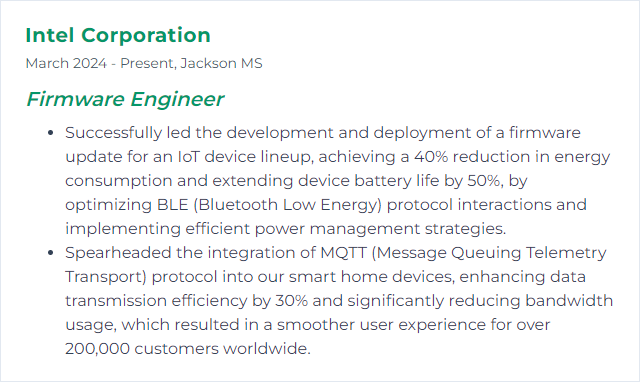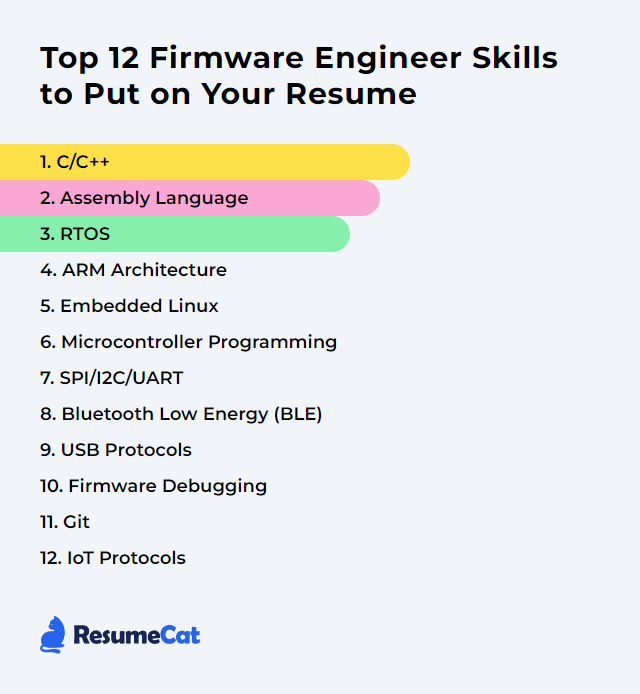Top 12 Firmware Engineer Skills to Put on Your Resume
Crafting a standout firmware resume means showing sharp technical instincts and the judgment to ship dependable systems under constraints. Employers want to see depth: how you design for real-time needs, squeeze cycles and bytes, and untangle gnarly hardware-software glitches. The skills below map the territory—core languages, platforms, protocols, and the debugging grit that keeps devices steady in the wild.
Firmware Engineer Skills
- C/C++
- Assembly Language
- RTOS
- ARM Architecture
- Embedded Linux
- Microcontroller Programming
- SPI/I2C/UART
- Bluetooth Low Energy (BLE)
- USB Protocols
- Firmware Debugging
- Git
- IoT Protocols
1. C/C++
C/C++ are the backbone languages for low-level and embedded work. C offers lean, predictable control over memory and hardware. C++ layers in abstractions that, used wisely, can tame complexity without sacrificing performance. Together, they let you drive peripherals, manage timing, and craft code that’s both tight and durable.
Why It's Important
C/C++ give direct access to hardware and deterministic control over resources, making them essential for building efficient, real-time firmware that meets strict timing, memory, and power budgets.
How to Improve C/C++ Skills
Nail the fundamentals: Pointers, memory lifetimes, value vs. reference semantics, and data layout. Know them cold.
Think in bits and cycles: Practice bitwise ops, fixed-point math, and cache-aware code. Measure, then optimize.
Build on real hardware: Write drivers for GPIO, timers, ADC/DAC, and DMA. Ship small projects that talk to sensors and actuators.
Use modern C++ carefully: RAII, move semantics, constexpr, and templates—only where they pay off in clarity and performance.
Code reviews and standards: Follow MISRA C/C++ or internal guidelines. Keep style consistent and intent obvious.
Tool up: Static analysis, sanitizers (where supported), map files, and compiler flags. Profile first, tweak later.
Concurrency basics: Understand ISR vs. thread context, lock-free patterns, and memory barriers on your target.
Read disassembly: Compare generated code across optimization levels. Learn what the compiler really emits.
Test relentlessly: Unit tests for logic, hardware-in-the-loop for behavior. Reproduce, then fix.
Keep learning: New compiler versions, C++20/23 features, and better idioms appear all the time.
How to Display C/C++ Skills on Your Resume
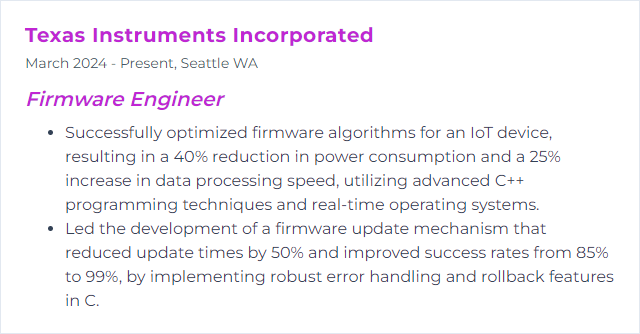
2. Assembly Language
Assembly maps almost one-to-one to machine code. It’s terse, unforgiving, and perfect when you need absolute control over performance, timing, or silicon quirks.
Why It's Important
Assembly lets firmware engineers fine-tune hotspots, craft precise ISRs, and understand what the CPU actually does—crucial for timing-critical or space-constrained code.
How to Improve Assembly Language Skills
Study the architecture: Pipelines, registers, calling conventions, and memory models for your target (ARM, RISC‑V, x86, etc.).
Read real code: Disassemble C/C++ output and learn patterns the compiler emits.
Write small routines: CRCs, context switches, memcpy/memset variants, and tight ISRs. Benchmark them.
Optimize with intention: Unroll only where it matters, schedule instructions to hide latency, mind alignment.
Debug fluently: Single-step, set watchpoints, and trace registers. Practice with hardware debuggers.
Mind portability: Isolate assembly in well-documented modules with clean C interfaces.
Keep notes: Gotchas and timing tables save future hours.
How to Display Assembly Language Skills on Your Resume
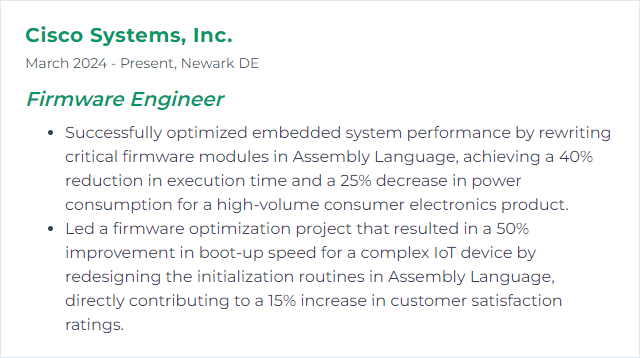
3. RTOS
An RTOS (Real-Time Operating System) schedules tasks, manages interrupts, and coordinates resources so work happens on time, every time. Determinism beats raw speed when deadlines matter.
Why It's Important
For embedded products with strict timing, an RTOS helps structure concurrency, isolate responsibilities, and guarantee response windows—raising reliability and easing maintenance.
How to Improve RTOS Skills
Task design: Choose priorities with care. Keep tasks focused; move heavy lifting out of ISRs.
Inter-task communication: Use queues, semaphores, and event groups thoughtfully. Avoid deadlocks and priority inversion (priority inheritance helps).
Memory strategy: Prefer static allocation. Use memory pools for predictable latency.
Timing and latency: Measure tick jitter, ISR latency, and context switch time. Tune scheduler and timer sources.
Power and idle: Integrate tickless idle and sleep states without breaking deadlines.
Trace and profile: Use system tracing to visualize task states, CPU load, and bottlenecks.
Fault handling: Add watchdogs, stack overflow checks, and robust error paths.
Safety and security: Code defensively; align with relevant standards (e.g., ISO 26262, IEC 62304) when applicable.
Code quality: Enforce coding standards, static analysis, and thorough documentation.
Test for worst case: Stress, soak, and corner‑case timing tests—prove deadlines under load.
How to Display RTOS Skills on Your Resume

4. ARM Architecture
ARM is a family of RISC cores known for performance per watt and pervasive adoption across embedded, mobile, and now servers. Understanding the architecture unlocks speed and battery life.
Why It's Important
Knowing ARM means writing firmware that’s efficient, secure, and portable across a wide ecosystem, with strong toolchain and vendor support.
How to Improve ARM Architecture Skills
Know the core: Thumb/Thumb‑2, pipeline behavior, exceptions, and calling conventions.
Exploit hardware features: Use DMA, timers, caches, FPU/NEON, and MPU/TrustZone where appropriate.
Power management: Sleep states, clock gating, and peripheral power domains—design for long battery life.
Interrupts done right: Keep ISRs tiny, use deferred work, and tune NVIC priorities carefully.
CMSIS and vendor HALs: Balance portability and performance; drop to registers when it counts.
Measure, don’t guess: Use cycle counters, trace, and logic analyzers to validate assumptions.
How to Display ARM Architecture Skills on Your Resume
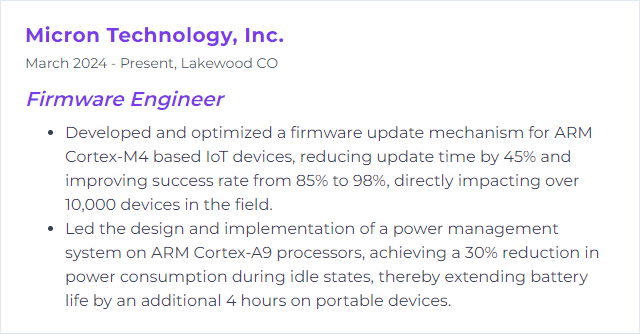
5. Embedded Linux
Embedded Linux is a tailored Linux stack for constrained devices. It brings drivers, networking, filesystems, and a familiar userspace—trimmed to fit, tuned to respond.
Why It's Important
It’s flexible, open, and battle‑tested. You can scale features up or down, secure it, and leverage a massive ecosystem for rapid development.
How to Improve Embedded Linux Skills
Faster boots: Trim services, parallelize init, and streamline device tree and kernel config.
Smaller images: Drop unneeded packages, prefer BusyBox, and compress wisely.
Security first: Least privilege, read‑only rootfs where possible, MAC frameworks (AppArmor/SELinux), and robust key handling.
Real-time needs: Use PREEMPT_RT or split critical work to a co‑processor/MCU.
Power savvy: cpufreq, cpuidle, and device power policies tuned to your workload.
Rock-solid updates: A/B or snapshot-based OTA, atomic installs, and rollback plans.
Profile the system: perf, ftrace, eBPF, and userspace profilers to spot hotspots.
Network tuning: Adjust queues, buffers, and offloads; test under loss and jitter.
Right filesystem: ext4, UBIFS, or F2FS—match wear, reliability, and performance needs.
Automate: CI for kernel, drivers, and userspace; hardware-in-the-loop tests catch regressions.
How to Display Embedded Linux Skills on Your Resume
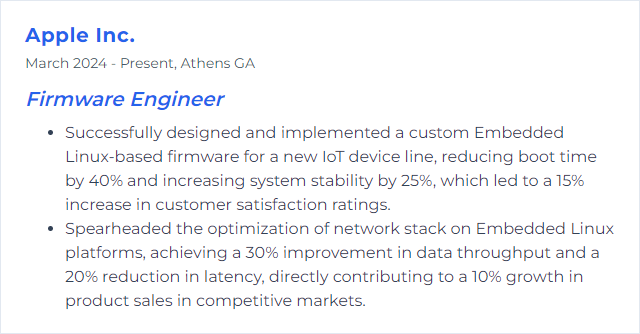
6. Microcontroller Programming
Microcontroller programming means writing firmware that speaks directly to peripherals and pins, orchestrates timing, and squeezes value from tiny memories and tight power budgets.
Why It's Important
It’s the heart of embedded products—reliable control, safe actuation, clean sensor reads, and predictable behavior under all conditions.
How to Improve Microcontroller Programming Skills
Master embedded C/C++: Volatile, qualifiers, bitfields, endianness, and link-time details.
Read the manuals: Datasheets and reference guides are truth. Build from them, not guesses.
Project practice: Timers, PWM motor control, sensor fusion, bootloaders—ship small, then bigger.
Use the right tools: Solid IDE or build system, unit tests, coverage where possible, and hardware debuggers.
Drivers with layers: Separate hardware access, logic, and application code to simplify testing.
RTOS when needed: Use tasks and queues to tame concurrency; avoid it when a simple main loop suffices.
Low-power patterns: Sleep states, wake sources, and peripheral gating baked into your design.
How to Display Microcontroller Programming Skills on Your Resume
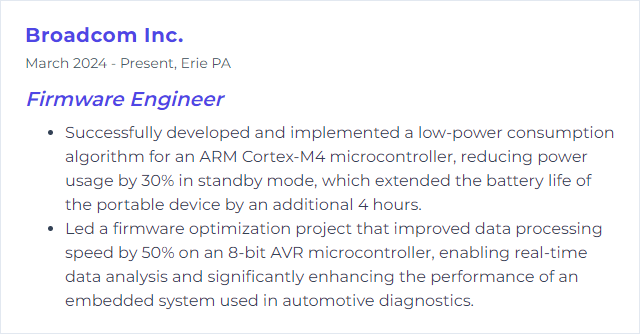
7. SPI/I2C/UART
SPI (Serial Peripheral Interface): Fast, synchronous, master‑slave with separate lines (MOSI/MISO/SCK/CS). Great for high‑throughput peripherals and deterministic timing.
I2C (Inter‑Integrated Circuit): Two-wire multi‑master bus (SDA/SCL) with addressing and open‑drain signaling. Perfect for sensor farms and low‑speed control.
UART (Universal Asynchronous Receiver/Transmitter): Simple, asynchronous serial with TX/RX, start/stop framing, and selectable baud. Ubiquitous for logs, bootloaders, and device-to-device links.
Why It's Important
These buses are the glue that binds microcontrollers to sensors, memory, radios, and other controllers. Without them, your system doesn’t talk.
How to Improve SPI/I2C/UART Skills
SPI (Serial Peripheral Interface)
- Push speed safely: Select clock polarity/phase correctly, validate at temperature and across boards.
- Tame noise: Short traces, proper impedance, and clean chip select timing. Shield and route thoughtfully.
- Use DMA: Offload bulk transfers; double‑buffer for continuous streams.
I2C (Inter-Integrated Circuit)
- Right pull‑ups: Size resistors for bus capacitance and desired speed. Verify rise times on a scope.
- Clock stretching & recovery: Handle slow devices, stuck lines, and bus resets gracefully.
- Addressing sanity: Plan addresses, support multiple instances, and detect collisions.
UART (Universal Asynchronous Receiver/Transmitter)
- Baud discipline: Match clocks and tolerances; verify framing and oversampling.
- Buffers and flow control: FIFOs, DMA, RTS/CTS or XON/XOFF to prevent overruns.
- Error handling: Parity, framing, and noise detection with robust recovery paths.
How to Display SPI/I2C/UART Skills on Your Resume
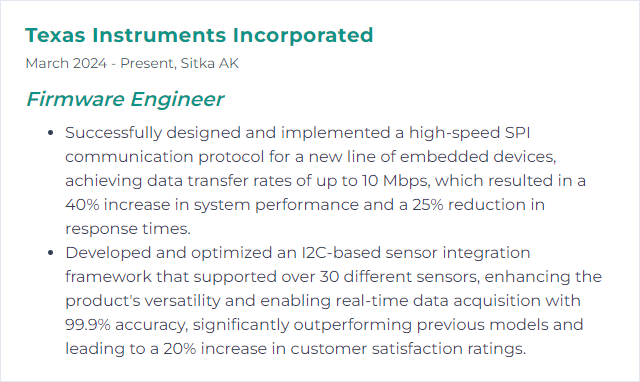
8. Bluetooth Low Energy (BLE)
BLE delivers low‑power, short‑range wireless links. It hinges on careful radio timing, smart connection parameters, and disciplined power management.
Why It's Important
For wearables, sensors, and battery‑powered IoT, BLE is the de facto path to phones and gateways—efficient and widely supported.
How to Improve Bluetooth Low Energy (BLE) Skills
Power strategy: Tune advertising and connection intervals, slave latency, and duty cycles. Sleep aggressively between events.
Throughput tuning: Use longer MTUs, data length extensions, and 2M PHY when supported. Batch where it helps.
Rock-solid links: Implement reconnect/backoff logic, channel map updates, and robust error handling.
Security: Pairing modes, bonding, encryption, and key rotation aligned with your threat model.
OTA updates: Safe, resumable firmware updates with integrity checks and rollback.
BLE 5.x features: Long Range (Coded PHY), extended advertising, periodic adv—use them when range or airtime demands it.
How to Display Bluetooth Low Energy (BLE) Skills on Your Resume

9. USB Protocols
USB defines how devices enumerate, negotiate power, and exchange data with a host. From low-speed HID to high-speed bulk transfers and Type‑C power delivery, the stack is deep but consistent.
Why It's Important
Understanding USB enables interoperable devices that pass compliance, handle edge cases, and work across hosts without drama.
How to Improve USB Protocols Skills
Master enumeration: Get descriptors perfect (device, config, interface, endpoints). Validate with analyzers.
Class savvy: HID, CDC, MSC, UVC—pick the right class and follow timing and packet rules.
Efficient transfers: Use double buffering, correct endpoint types, and tune packet sizes for each speed tier.
Power management: Respect suspend/resume, remote wake, and Type‑C current/PD rules.
Error robustness: Handle stalls, retries, and short packets. Recover cleanly from host hiccups.
Interoperability testing: Test across OS versions, hubs, cables, and hosts. Automate where you can.
Security posture: Validate inputs, limit endpoints, and lock down DFU paths.
Backward/forward support: Design for USB 2.0 and 3.x as needed; be explicit about capabilities.
How to Display USB Protocols Skills on Your Resume

10. Firmware Debugging
Firmware debugging is the craft of catching logic slips, timing traps, and hardware gremlins—then fixing them without collateral damage.
Why It's Important
Reliability hinges on it. Debugging turns mysterious resets and missed deadlines into measurable, fixable causes.
How to Improve Firmware Debugging Skills
Use the right probes: J‑Link, OpenOCD, and target‑specific debuggers with SWD/JTAG, SWO/ETM trace.
Instrument wisely: Lightweight logging, ring buffers, and event tracing that won’t disturb timing.
Test in layers: Unit tests, integration tests, and hardware‑in‑the‑loop scenarios.
Static and dynamic checks: Static analysis, stack guards, race detectors (where available), and watchdogs.
Bisect with version control: Small commits, clear messages, and binary search for regressions.
Simulate when helpful: Emulators and QEMU‑style targets to reproduce edge cases.
Peer reviews: Fresh eyes spot assumptions you’ve gone blind to.
How to Display Firmware Debugging Skills on Your Resume

11. Git
Git tracks changes, branches ideas, and stitches work together. For firmware, it’s the safety net when hardware changes and deadlines collide.
Why It's Important
Version control keeps history clean, enables confident collaboration, and makes releases reproducible—vital when supporting devices in the field.
How to Improve Git Skills
Branching strategy: Feature branches, release branches, and hotfixes with clear policies.
Clean commits: Small, focused commits with messages that explain the why, not just the what.
Rebase and cherry‑pick: Keep history readable; move fixes where they’re needed.
Hooks and checks: Pre‑commit formatting, static analysis, and commit message linting.
Tags and releases: Signed tags, changelogs, and artifacts for every build you ship.
CI integration: Build, test, and package on every push. Add hardware tests when practical.
Submodules or package managers: Manage third‑party code predictably; pin versions.
How to Display Git Skills on Your Resume

12. IoT Protocols
IoT protocols define how constrained devices talk—securely, efficiently, and reliably—across lossy networks and tight energy budgets.
Why It's Important
Choosing and implementing the right protocol stack ensures devices connect, interoperate, and survive in real deployments.
How to Improve IoT Protocols Skills
Security baked in: TLS/DTLS, strong keys, secure boot, and authenticated updates—not afterthoughts.
Pick the right fit: MQTT, MQTT‑SN, CoAP, or HTTP/HTTP/2 depending on latency, reliability, and payload needs.
Packet thrift: Compact encodings (e.g., CBOR, MessagePack) and delta updates to save airtime and power.
Sleep smart: Duty cycling, batching, and adaptive reporting to stretch batteries.
Resilience: Retries with backoff, idempotent ops, and offline buffers for flaky links.
Observability: Telemetry for latency, loss, and retries; dashboards to spot drift early.
Documentation: Clear wire formats, versioning, and migration paths so ecosystems don’t fracture.
How to Display IoT Protocols Skills on Your Resume
